Improving maternal and infant nutrition: a framework for action
Actions which can be taken by NHS Boards, local authorities and others to improve the nutrition of pregnant women, babies and young children.
Chapter 3: What is Known about Maternal and Infant Nutrition in Scotland?
Introduction
3.1 The Public Health Observatory Division at NHS Health Scotland undertook a review to describe current maternal and infant diet and nutritional status in Scotland. 53 The full review is available on the Scottish Public Health Observatory (Scot PHO) website at www.scotpho.org.uk
3.2 This chapter presents an overview of the findings of the review. The objectives of the review were to:
- Detail the current availability of maternal and infant nutrition information in Scotland from national surveys, routinely collected data and robust ad hoc data sources;
- Identify potential nutritional status and dietary indicators that can be used to assess maternal and infant nutrient intake and nutritional status in Scotland; and
- Assess where possible, using these indicators, maternal prenatal and postnatal diet and nutritional status, breastfeeding, weaning, and the diet and nutritional status of infants after weaning in Scotland.
Approach
3.3 The review was structured around key phases in pregnancy and infancy, from pre-conception up to the infant's third birthday. It compiled existing published information and some secondary analysis of existing data sets: no new data collection was undertaken.
3.4 Relevant data from routine sources, including regularly conducted surveys, in Scotland was sought. Where this was not available, one-off nationally representative surveys in Scotland or the UK were sought. (Most UK-wide nutritional studies have small Scottish samples that may not be adequately representative.) All non- UK studies were excluded.
3.5 The review assessed the data available on general diet, nutrient intake and nutritional status of some of the key vitamins and minerals, maternal obesity, birth weight, breastfeeding, formula feeding and complementary feeding. Based on advice from public health nutritionists, the key vitamins and minerals included were vitamin D, folate, iron and calcium.
What Information is Available?
3.6 There are limited data available on maternal and infant nutrition in Scotland. Many of the sources used were not recent and/or had small samples not adequately representative of the Scottish population. For example, all three relevant UK National Diet and Nutrition Surveys had small Scottish samples. 54-56 There is no routinely collected data in Scotland on maternal nutrition before, during or after pregnancy. The diet of women of childbearing age was used as a proxy because some studies suggest little change in pregnancy from prior dietary patterns. There are some data collected on infant nutrition in Scotland, mainly breastfeeding. Little is collected after the routine 6-8 week review until the start of school at around five years of age.
3.7 Making comparisons between different sources or over time is difficult. Results can be reported for dietary intake, nutrient intake, nutritional status or a combination of these (and other intake such as supplements). Results may be presented as means, medians or proportions in relation to thresholds, and for inconsistent age groupings. A recent review of progress towards the Scottish Dietary Targets indicated that there has been little change in the overall diet of the general population in Scotland since 2001; only very small improvements were made towards achieving targets for fruit and vegetables, brown/wholemeal bread and oil rich fish between 2001 and 2006 and there was no reduction in the intake of fat, saturated fat, and added sugar, all of which remained considerably higher than the targets. 1 Deprived households in Scotland continue to have a poorer quality diet. Increasing deprivation, decreasing income and decreasing social class have been linked to more energy dense eating patterns in Scotland. 55
What does the Information Available tell us about Maternal Nutrition?
Women of Childbearing Age and During Pregnancy
3.8 There was no national data available to describe the nutritional status of women during pregnancy and following birth. However, data from national dietary surveys can indicate the nutritional status of women of childbearing age and their likely nutritional state at the start of pregnancy. These surveys suggest that most women do not follow current dietary guidelines. Diets continue to be high in saturated fat and sugar and below the recommended intakes for fruit and vegetables, oily fish and dietary fibre. 54, 58 There appears to be little improvement in women's diets over time, however the information available is limited. 57
3.9 In 2008 over half of women (52%) aged 16-44 years in Scotland were classified as overweight or obese. 5 Obesity during pregnancy is associated with an increased health risk to both mother and infant. 21 While height and weight of the mother is recorded at the first NHS appointment of her pregnancy, this data is not published although work is underway to assess the quality of this data.
3.10 The poorest diets are consistently found in women from the most disadvantaged groups. In an Aberdeen cohort study, poor food choices during pregnancy were consistent with poor nutrient intakes and there was a strong social gradient. 59 The study found that women in the most deprived groups had lower intakes of fruit and vegetables and oily fish and had higher intakes of processed meat, fried potatoes, crisps and snacks, milk and cream, and soft drinks than women in the least deprived areas. As a consequence, the nutrient intake of the most deprived women was lower in protein, non-starch polysaccharides and most vitamins and minerals.
3.11 Analysis of data from the Scottish Health Survey suggested that younger adults were more likely to have a poorer quality diet. 5 Based on the National Diet and Nutrition Survey 60 , the Scientific Advisory Committee on Nutrition identified adolescent girls and young women in the UK as one of the groups most at risk of poor dietary variety and low nutrient intake and nutrient status. 61 It is likely that a significant proportion of young women enter pregnancy with suboptimal levels of some nutrients.
3.12 More than one quarter (28%) of women in the UK had low vitamin D status in 2000-01. 59 There is no data available on uptake of vitamin D supplementation during pregnancy or while breastfeeding in Scotland or in the UK.
3.13 Over 10% of women from low income households in Scotland and the UK were deficient in folate in 2003-05. 58 In 2005 a high proportion of women (77%) in Scotland reported taking a folic acid supplement at some point during the first three months of pregnancy. 29 However, it is not clear whether the amount of folic acid taken and the timing was consistent with the advised level. The Southampton Women's Study assessed folic acid intake in 203 pregnant women aged 20-34 years of age at 11 weeks gestation. Nearly all (93%) were taking some folic acid supplements but only 12% were taking the recommended 400 micrograms a day of supplements. 62 It is likely, therefore, that folate supplementation remains inadequate in the majority of women during early pregnancy.
3.14 Almost half (49%) of young women from low income households in the UK had low iron intakes in 2003-05 and 21% had low iron stores. 58 No large scale studies of iron status during pregnancy in Scotland were identified.
3.15 A high proportion of women of childbearing age met the recommended intake of calcium in 2000-01. 60 However, 15% of women from low income households in the UK had low calcium intakes in 2003-05. 58 The Aberdeen cohort study was the only study identified that reported calcium intake in women during pregnancy in Scotland. 59 The study which presented results by SIMD (Scottish Index of Multiple Deprivation) decile found no significant difference in calcium intake in pregnant women by deprivation category.
Women Following Birth
3.16 No Scottish or UK studies providing robust measurement of nutrient intake or nutrient status of women following birth were identified.
3.17 Information on maternal weight following birth is not routinely collected in Scotland. While the opportunity to measure and record maternal weight is possible during routine appointments following birth, there are no mandatory weight measurements recorded.
What does the Information Available tell us about Infant Nutrition?
Birth Weight of Infant
3.18 Although birth weight is particularly influenced by maternal weight at conception, it also reflects maternal nutrition during pregnancy and gives an indication of the nutrition received by the developing infant. 13
Birth weight of infants born in Scotland is published by the Information Services Division ( ISD) Scotland. 63 The proportion of full term infants born in Scotland with low birth weight has remained at a similar level since 1988 with under 3% having low birth weight (below 2,500 grams) and less than 0.05% having very low birth weight (below 1,500g). Around 1% of babies born in Scotland have a very low birth weight, and there is a distinctive deprivation gradient in low birth weight babies in Scotland - with almost three times as many born to mothers from the most deprived areas. 63 It is possible that the recent increase in levels of obesity in Scotland may be having an effect on birth weight. However, while data is collected on birth weight in Scotland there are no current definitions of 'high' birth weight, consequently this is not routinely published.
Breastfeeding
3.19 The World Health Organisation ( WHO) defines exclusive breastfeeding as giving no other food or drink - not even water - except breast milk. 64 It does however allow the infant to receive drops and syrups such as vitamin and mineral supplements and medicines. The Infant Feeding Survey uses this definition to report data on exclusive breastfeeding. Mixed breastfeeding is defined as receiving both breast milk and formula milk or other milk. 30
3.20 Breastfeeding data published by ISD Scotland provides only an indicator of exclusive breastfeeding and does not match the WHO definition. 65 The mother is asked whether the infant is exclusively breastfed, exclusively formula fed or receiving mixed feeding (both breast and formula). In the past there has probably been some variation in how this question is asked. In order to improve consistency, recent guidance for public health nurses specifies the feeding method recorded on Child Health Systems Programme - Pre-School ( CHSP- PS) system should relate to the type of feeding in the last 24 hours.
Survey Data
3.21 The Infant Feeding Survey is conducted every five years in the UK and assesses the feeding methods of infants from birth to 9-12 months of age. 30 In 2005, the incidence of breastfeeding was 70% in Scotland, with a strong rise since 1990 (Figure 1). Other UK countries have also shown increases. Breastfeeding is more common in mothers with higher educational levels, those aged 30 or over, first time mothers and those from managerial and professional occupations.
Figure 1: Incidence of Breastfeeding Initiation by UK Country, 1980 to 2005
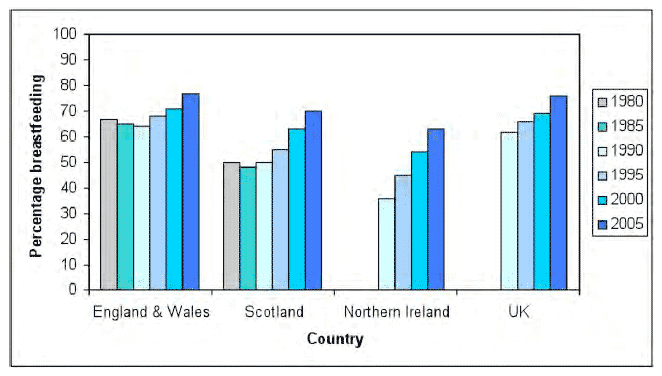
Source: Infant Feeding Survey 2005 - Stage 1 (Infants aged 4-10 weeks old).
The Infant Feeding Survey (2005) showed that breastfeeding rates in Scotland fell rapidly from 70% initiation to 57% at 1 week, 44% at 6 weeks and 24% at 6 months (Figure 2).
Figure 2: Prevalence of Breastfeeding at Ages up to 9 Months by Country
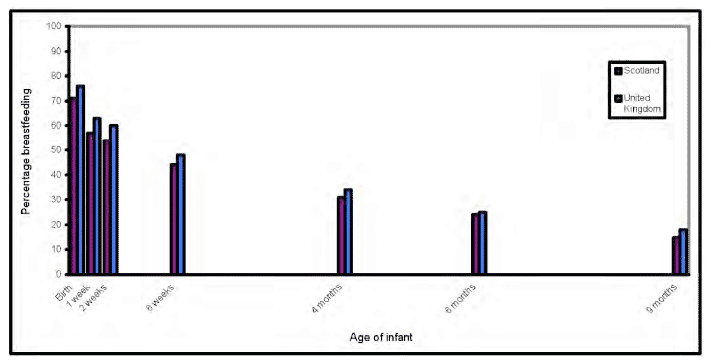
Source: Infant Feeding Survey 2005
Routinely Collected Data
3.22 Information on feeding method is collated for the 12 NHS Boards participating in the CHSP- PS system and is published by ISD Scotland (all Boards except Grampian)
Breastfeeding at Birth
3.23 Information on breastfeeding at birth is collected at the first visit review with the public health nurse when the infant is around eleven days old. ISD Scotland data show that 60% of mothers were breastfeeding in total (including those using a combination of breastfeeding and formula feeding) and 56% were exclusively breastfeeding in Scotland at birth in 2009 (Figure 3). This is a slight increase from 56% total breastfeeding and 52% exclusively breastfeeding in 2001. As this information is collected at the first visit review it relies on the mother recalling the information and could therefore overestimate breastfeeding rates. It is notable that these data, covering approximately 90% of births in Scotland, suggest breastfeeding initiation rates are lower than reported by surveys, which may use different definitions and experience selective participation.
Figure 3: Breastfeeding Rates at Birth in Scotland by Year of Birth, 2001 to 2009
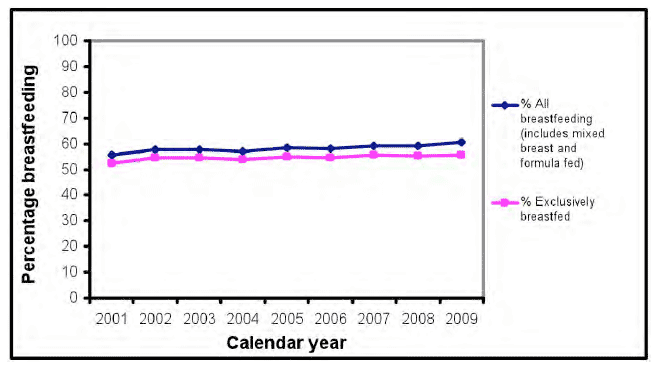
Source: ISD Scotland. Data for 2009 are provisional and are estimated to be around 99% complete.
Breastfeeding at the First Visit Review
3.24 In 2009, 46% of mothers in Scotland were breastfeeding in total (including those using a combination of breastfeeding and formula feeding) and 37% were exclusively breastfeeding at the first visit review (Figure 4). Breastfeeding rates at this ten day visit have changed little since 2001.
Figure 4: Breastfeeding at the First Visit Review in Scotland by Year of Birth, 2001 to 2009
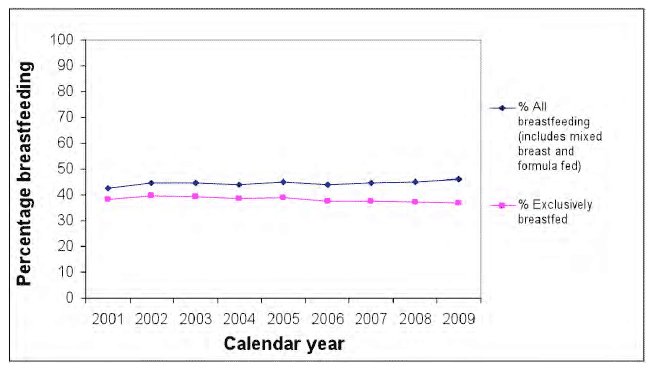
Source: ISD Scotland. Data for 2009 are provisional and are estimated to be around 99% complete.
Breastfeeding at the 6-8 week Review
3.25 At the 6-8 week review, 36% of mothers in Scotland were breastfeeding in total and 27% were exclusively breastfeeding in 2009 (Figure 5). The rates have changed minimally since 2001. The Scottish Government has set NHS Boards a health improvement target to increase the proportion of infants exclusively breastfed at 6-8 weeks to from 26.6% in 2006/07 to 33.3% by 2010/11. 66
Figure 5: Breastfeeding at the 6-8 week Review in Scotland by Year of Birth, 2001 to 2009
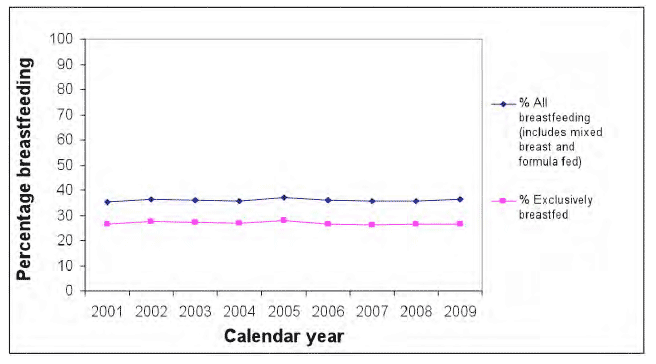
Source: ISD Scotland. Data for 2009 are provisional and are estimated to be around 90% complete.
3.26 After the 6-8 week review no further data is routinely collected on infant feeding method in Scotland. Survey data is available from the Infant Feeding Survey on the proportion of mothers breastfeeding up to the age of nine months. By six months, only 24% of mothers in Scotland were still breastfeeding - around one in three of the 71% who initiate breastfeeding.
Breastfeeding and Deprivation
3.27 There is an association between maternal deprivation and breastfeeding (Figure 6). This is seen at birth, the first visit review (when the infant is around ten days old) and the 6-8 week review. In 2009, 67% of mothers in the least deprived quintiles in Scotland were breastfeeding at the first visit review compared with 30% in the most deprived quintiles. At the 6-8 week review 57% of mothers in the least deprived quintiles were breastfeeding compared with 22% of mothers in the most deprived quintiles. The gap between the least and most deprived areas narrowed slightly between 2001 and 2009 because rates in the most deprived areas increased and rates in the least deprived areas were static (Figure 6). Similar trends were seen with breastfeeding rates at birth and at the first visit review.
Figure 6: Breastfeeding at the 6-8 week Review by Deprivation in Scotland, 2001 to 2009
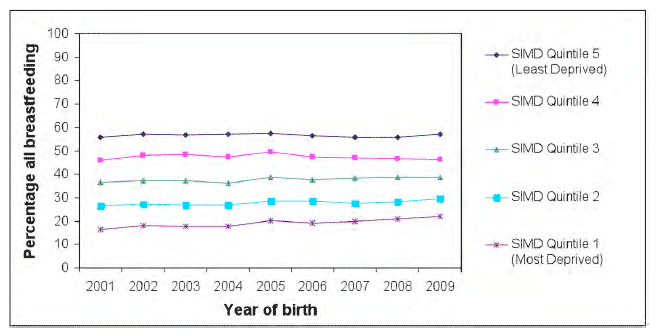
Source: ISD Scotland. Data for 2009 are provisional and are estimated to be around 90% complete.
Breastfeeding and Maternal Age
3.28 Older mothers are more likely to breastfeed than younger mothers at both the first visit review and the 6-8 week review in Scotland. In 2009 only 15% of mothers aged 20 years and under in Scotland were reported to be breastfeeding at the first visit review compared with 60% of mothers aged 40 years and older. This was similar at the 6-8 week review with 9% of mothers aged 20 years and under breastfeeding compared with 52% of mothers aged 40 years and older. Data from the Infant Feeding Survey suggest this pattern is similar in all countries in the UK.
Formula Feeding
3.29 The Infant Feeding Survey collects data on formula feeding. The 2005 survey showed that 38% of mothers in Scotland had first introduced infant formula into their infant's diet at birth increasing to 98% by nine months of age. In the same year, 57% of mothers in Scotland were giving infant formula at all or almost all feeds by age 4-10 weeks.
3.30 The Infant Feeding Survey compared how mothers reported preparing infant formula with the recommended Food Standards Agency guidelines. Infant formula is not sterile and good hygiene practices are essential when preparing formula to decrease the chances of infants becoming ill. The main three recommendations are:
1. Ideally each bottle should be made fresh for each feed and formula milk should not be stored for future use.
2. Boiled tap water that has been allowed to cool for no more than 30 minutes should be used to make infant formula (natural mineral water should not be used as this contains high levels of minerals and can be harmful to the infant).
3. Water should be added to the bottle first before adding the powdered infant formula.
3.31 Only 10% of mothers using infant formula in Scotland followed all these recommendations.
3.32 The Food Standards Agency states that follow-on formula is not necessary in the infant's diet at any stage and instead full fat cows' milk should gradually be introduced into the diet from 12 months of age. 67 Follow-on milks are designed and promoted to be used between formula milk and the introduction of cows' milk at 12 months of age. Although follow-on milk is not suitable for infants under six months of age (as it is difficult for the infant to digest), 10% of mothers in Scotland had given follow-on milk to their infant before this stage.
Complementary Feeding (Introduction of Solid Foods)
3.33 There is a general shift towards mothers introducing solid foods into the infant's diet at a later stage which may have a beneficial effect on future levels of obesity in children (Figure 7). By four months of age 60% of mothers in Scotland participating in the Infant Feeding Survey had introduced solids into their infant's diet in 2005 compared with 83% in 2000 and 91% in 1995. By five months of age 85% of mothers in Scotland had introduced solids into their infant's diet in 2005 compared with 98% in 2000.
Figure 7: Percentage of Mothers who had Introduced solids at 4 Months of Age by UK Country, 1995 to 2005
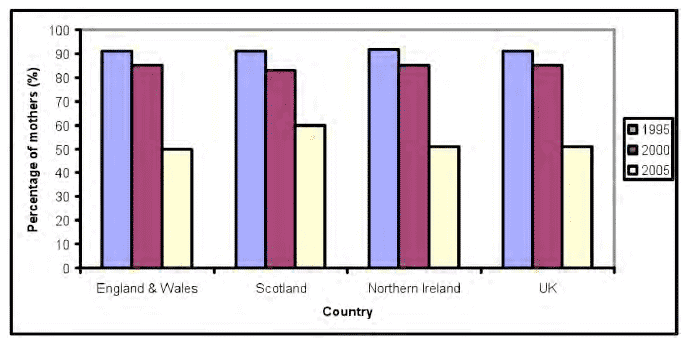
Source: Infant Feeding Survey 2005
3.34 While these results show a general shift towards mothers following the revised WHO guidelines, only 2% of mothers in the UK in 2005 waited until six months of age before introducing solid foods into the infant's diet. 30 The nature and timing of weaning varies by the mother's socio-economic status with deprivation having a strong predictive effect on weaning before four months 31 . The Infant Feeding Survey found that women in managerial/professional occupations were more likely to feed their infants fruit and vegetables rather than sweets or other snacks. 30
3.35 Data on infant weight and weight gain in Scotland is not routinely collected. While the opportunity to measure and record infant weight is possible during routine appointments within the NHS, there are currently no mandatory growth measurements recorded following the 6-8 week review until the infant starts school at around 5 years of age.
3.36 After the initiation of weaning no recent large scale studies on nutritional status or nutrient intakes of vitamin D, iron or calcium in infants in Scotland were identified. However the Avon Longitudinal Study of Parents and Children ( ALSPAC) study provides more recent evidence from southern England and suggests that while vitamin D levels were still below the RNI, iron intake was higher for this sample of infants at eight months and 12 months of age with only a small proportion of infants found to be anaemic. 68
Conclusion
3.37 There is neither sufficient nor sufficiently timely data on maternal and infant nutrition in Scotland. Some of the main sources have limited Scottish samples and are conducted very infrequently. Different sources report their results in different ways, thus comparison between sources, or over time, is difficult. The sources available do not enable a comprehensive description of maternal and infant nutrition in Scotland in 2010 to be given. The pace of improvement in maternal and infant nutrition appears, however, to be slow.
What Next?
3.38 There are many gaps and inadequacies in the available information but improvements are being made. The new format of the UK National Diet and Nutrition Survey of adults and children has an increased Scottish sample (results available in 2012). A new UK nutrition survey for infants (age 4 to 18 months) is being piloted. The scope for acquiring better nutrition information from existing Scottish surveys, such as the Scottish Health Survey and Growing Up in Scotland study, should be explored. There may also be potential for routine administrative and clinical data sources to provide national information.
3.39 Assessing the impact of the Maternal and Infant Nutrition Framework will require a monitoring framework that is consistent, scientifically well-founded and achievable without significant diversion of resources that might be used to implement the Framework. The maximum use should thus be made of existing routine administrative, clinical and survey data sources.
There is a problem
Thanks for your feedback